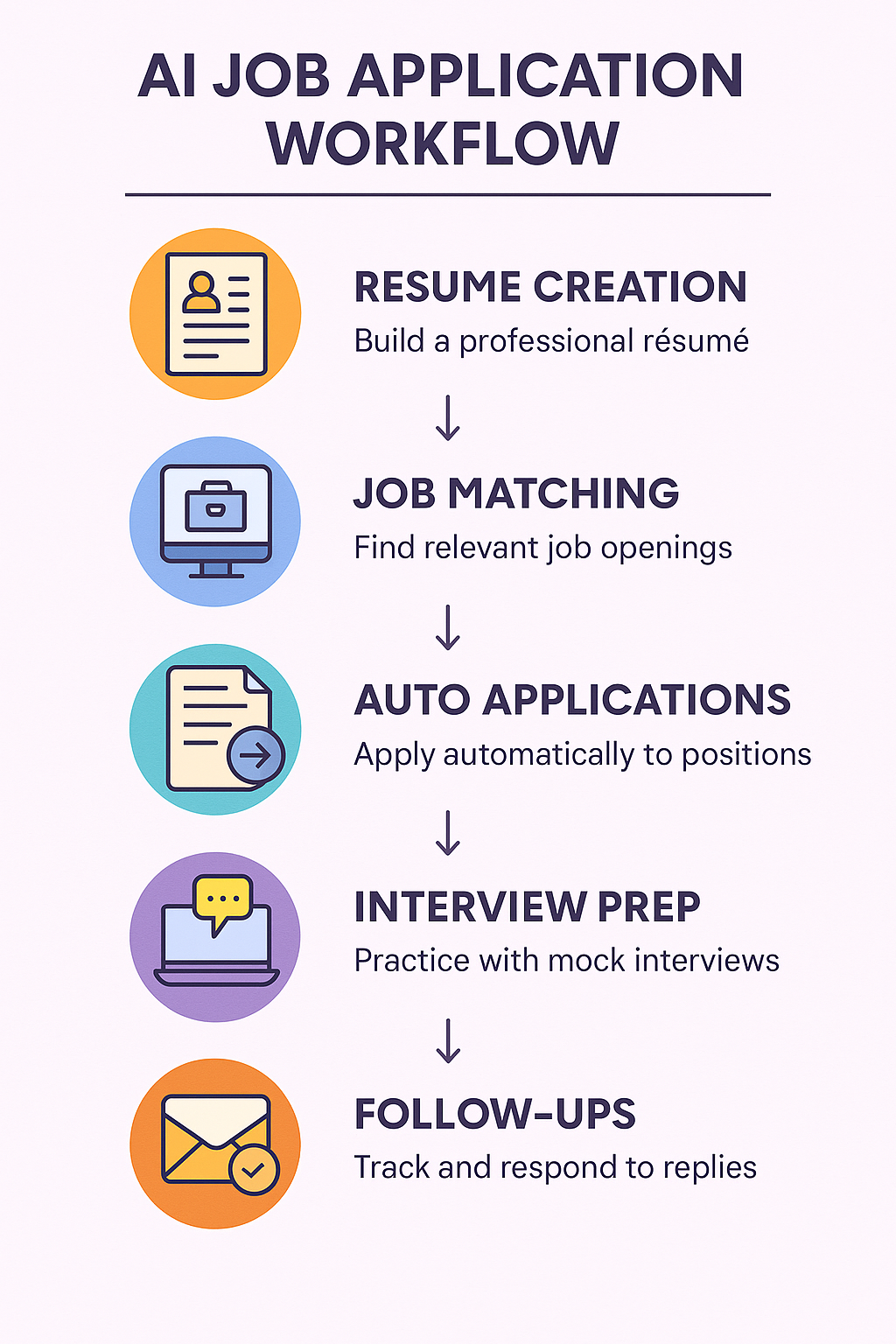The 8 Best AI Job Application Tools (for 2025)
Searching for the perfect job can feel like navigating a vast maze, especially with AI-powered tools and their various AI features available.
But fear not, job seekers. Just as a map simplifies the complexities of a labyrinth, AI job application tools, which are AI-powered tools, are revolutionizing the hiring landscape. These tools empower candidates with tailored job matches, automated applications, and insightful analytics.
Today, harnessing these innovative technologies can mean distinguishing yourself in a world teeming with opportunity, turning potential obstacles into stepping stones toward your dream career.
Let's explore the best AI tools that transform job applications into a streamlined, productive endeavor.
What are the AI Job Application Tools?
The AI job application tools are revolutionizing the job seeking process by leveraging advanced technologies that save time and increase efficiency, thus offering new avenues for career success.
These tools utilize cutting-edge algorithms and AI-driven features to automate monotonous tasks.
From crafting compelling resumes to optimizing job search strategies, these tools provide a plethora of capabilities that cater to a variety of job seekers, empowering them with confidence, adaptability, and the assurance of putting their best foot forward.
By intelligently analyzing trends and tailoring applications to fit job descriptions, AI job application tools serve as a beacon of hope in a landscape often dictated by stiff competition. They facilitate the "match" between candidate and opportunity, thus ensuring a more harmonious and timely convergence of aspirations and attainability.
AI job application tools can significantly improve your job search process by helping you find jobs with the addition of a job tracker and the ability to auto apply , making it more efficient and targeted.
They provide insights not only into the application but also into the applicant. They help highlight areas of strength and growth, allowing individuals to tailor their applications for optimal impact. This adaptability can lead to significant improvements in resume quality and application strategy.
Making Resume Writing a Piece of Cake!
Leveraging advanced AI job application tools can transform the process of crafting an AI resume. First impressions matter most, and a standout resume becomes a paramount tool in one's career arsenal. AI-driven platforms are revolutionizing resume writing by tailoring content to meet specific job criteria.
AI Job Application Workflow

The 8 Best AI Job Application Tools!
1. Loopcv
Best for: Full automation of the job search
Loopcv automates the entire job application process—from finding job listings to customizing and submitting your resume. It also tracks responses and optimizes applications based on feedback, making it ideal for high-volume job seekers.
2. Jobscan
Best for: Resume optimization and ATS compatibility
Jobscan compares your resume to a job description and offers targeted suggestions to improve alignment with Applicant Tracking Systems (ATS). It’s a must-use for tailoring resumes and increasing interview chances.
3. Resume.io
Best for: Easy resume and cover letter creation
Resume.io offers sleek templates, real-time formatting, and AI-assisted writing tips. It helps users craft polished, professional resumes and cover letters without needing design or writing expertise.
4. CoverLetterGPT
Best for: Generating custom cover letters
This tool uses AI to write personalized, well-structured cover letters based on your resume and the job description. It speeds up the process while ensuring the final result is aligned with what hiring managers look for.
5. Teal
Best for: Organizing your job search
Teal is a job tracker that lets you save roles, track application statuses, and store different resume versions. It also provides AI-powered insights and resume tips to streamline your entire job hunt.
6. Kickresume
Best for: Visually impressive resumes and personal branding
Kickresume provides beautiful, customizable resume and cover letter templates with AI assistance. It's ideal for creatives or anyone who wants a stand-out design with optimized content.
7. Grammarly
Best for: Writing clarity and tone refinement
Grammarly isn’t job-specific, but it's essential for polishing resumes, cover letters, and outreach emails. It ensures your application materials are grammatically correct, clear, and professionally toned.
8. AIApply
Best for: Bulk job applications and performance tracking
AIApply enables users to apply to many jobs at once, while tracking which resumes work best. It uses data to help refine your application strategy, making your efforts smarter over time.
Tool Name | Resume Builder | Cover Letter Assistant | Smart Job Matching | Auto Applications | Interview Prep | Job Tracker | Best For |
|---|---|---|---|---|---|---|---|
Loopcv | ✅ | ✅ | ✅ | ✅ | ❌ | ✅ | Automating the entire job application process |
Jobscan | ✅ | ❌ | ✅ | ❌ | ❌ | ✅ | Resume optimization & ATS matching |
✅ | ✅ | ❌ | ❌ | ❌ | ✅ | Creating stylish, effective resumes | |
Resumake | ✅ | ❌ | ❌ | ❌ | ❌ | ❌ | Free, simple resume generation |
Grammarly | ❌ | ✅ | ❌ | ❌ | ✅ | ❌ | Polishing resumes & cover letters |
CoverLetterGPT | ❌ | ✅ | ✅ | ❌ | ✅ | ❌ | Generating tailored cover letters |
Teal | ✅ | ✅ | ✅ | ❌ | ✅ | ✅ | End-to-end job search management |
Kickresume | ✅ | ✅ | ❌ | ❌ | ❌ | ✅ | Personal branding & resume design |
Streamlining Cover Letters
Crafting the perfect cover letter has historically been a daunting aspect of job applications. But how can AI job application tools transform this challenge into an opportunity for applicants' success by preparing them for common interview questions ?
Since 2016, advancements in AI technology have ushered in a new era of personalized assistance, allowing job seekers to create distinctive cover letters that stand out and apply for more jobs. These tools analyze job descriptions and draw insights from applicants' experiences to suggest compelling interview questions and answers that align with employer expectations.
Consequently, it's no longer necessary for applicants to reinvent the wheel with every application. AI tools such as Grammarly and CoverLetterGPT provide tailored phrases and stylistic suggestions that map directly to the core competencies desired by hiring managers, accelerating the cover letter creation process.
This revolutionary approach enables users to focus on the value they bring. Instead of getting bogged down with writing mechanics, they can invest their energy into defining and articulating their unique selling propositions, vital to clinching that dream job.
By leveraging AI, job seekers can effortlessly convey their passions and skills through polished and resonate cover letters to land jobs , ensuring they leave a robust and affirmative impression.
Smart Job Matching
Smart job matching has transformed the job search by aligning aspirations with opportunities that truly resonate.
Through AI-driven intelligent algorithms and cutting-edge platforms, candidates can discover roles tailored to their specific skills and interests, rather than sifting through extensive lists of unrelated openings. This technology not only saves time but also enhances the candidate's ability to focus on positions where they can truly excel, thereby significantly increasing the likelihood of a successful match.
Consequently, job seekers benefit from a personalized experience that was once unimaginable.
By analyzing job descriptions and candidate profiles, these tools recommend relevant positions, facilitating strategic career advancements and opening doors to roles perfectly suited to individual expertise.
The integration of smart job matching within AI job application tools provides an inspiring glimpse into a job market driven by purpose.
As these tools refine and expand their capabilities, candidates are empowered by the opportunity to connect with employers in more meaningful ways, transcending conventional boundaries and capitalizing on the momentum of a profoundly interconnected future.
Interview Preparation Features
AI tools redefine interview readiness.
With cutting-edge AI job application tools, interview preparation has reached new heights. These tools empower users by providing tailored practice sessions and insights into effective communication strategies, allowing candidates to reduce interview anxiety and improve their performance.
Crucially, users can also access assessments of strengths and weaknesses to hone their skills.
Such features are invaluable in an era of fierce competition - they transform the challenge of interviews into a manageable and structured process. By simulating real-world interview scenarios, AI-driven platforms revolutionize pre-interview practice.
By offering personalized feedback and training resources, these AI tools contribute significantly to interview success, preparing candidates not only for 2023 but for a future that promises even more exciting possibilities. Users witness optimized career journeys and elevated confidence through strategic, well-prepared engagements.
Personalized Job Alerts
AI job application tools have revolutionized the job search process by providing personalized job alerts that align with your specific career objectives. With these innovative technologies, you receive alerts tailored to your unique preferences.
These alerts ensure that opportunities perfectly match your skill set. Users can focus on preparing for interviews rather than spending hours sifting through irrelevant listings.
Empowering users with smart configurations, these platforms allow you to set a variety of filters and criteria – such as industry level, location, and desired salary – that fine-tune your job search to impeccably fit your aspirations. Opportunities that align with your goals are delivered directly to you.
In the competitive landscape of job applications, having this level of personalization at your fingertips is a game-changer. No longer are you bound to generic postings; instead, you are strategically guided toward the most promising openings.
It is this blending of AI precision and individual ambition that inspires confidence, ensuring that every alert is not merely another job opportunity but a potential catalyst for the next exhilarating chapter of your career.
Automating Job Applications
Streamline your job search with automation tools.
In today's fast-paced job market, efficiency is key. AI job application tools allow you to expand the horizons of application submission, doing so at unparalleled speeds to submit jobs faster with precise targeting of relevant positions, thus helping you save time and invaluable effort.
Fortunately, tools like Loopcv excel in the automation of application processes, giving you a strategic edge by submitting expertly crafted resumes.
Stay focused while AI manages submissions.
These advancements relieve the burden of - or even remove the need for - manually sending applications to multiple employers. Essentially, they allow candidates to remain proactive, adjusting quickly to real-time feedback from potential employers.
Monitoring Application Status
Keeping track of your job applications is paramount, ensuring that every opportunity is acknowledged and pursued with diligence.
With the multitude of applications submitted through AI tools, monitoring the responses can feel overwhelming and hinder your progress.
However, specialized job application platforms offer intricate tracking systems, transforming this task into a seamless experience. These systems not only notify candidates of status changes but also provide insights on when it's optimal to follow up, ensuring you stay active and informed throughout the entire process.
Moreover, these platforms empower you with a consolidated dashboard of all ongoing applications, fostering a structured approach. By understanding where each application stands, you gain a competitive advantage, enabling you to tailor your communication and follow-up strategy to each specific opportunity.
Are you ready to revolutionize your job search with the power of intelligent technology like never before?
emerged as a groundbreaking application aimed at simplifying the exhaustive process of job searching. Its sophisticated algorithms tirelessly scour job boards, matching candidates with opportunities that align perfectly with their career aspirations.
Now, it's more than just a tool; it's your secret weapon in navigating the complexities of the recruitment realm. Loopcv's prowess lies in its ability to automatically send applications on your behalf, increasing your exposure and maximizing the chances of landing interviews.
Harnessing the power of AI, this tool also provides crucial insights into hiring trends, empowering users with data-driven strategies tailored to the evolving landscape. With Loopcv, you gain not just visibility, but also a strategic edge.
In a competitive market, this tool can be the catalyst to your career growth journey. Invest in Loopcv and reinvent your job search strategy.
Understanding AI Algorithms
AI algorithms, the backbone behind innovative tools like Loopcv, reshape how we perceive and engage with job applications. They perform the heavy lifting, analyzing data with unparalleled precision.
The algorithms identify patterns and trends that may not be immediately apparent to human observers. These insights are invaluable for job seekers eager to optimize their efforts.
Essentially, AI algorithms enhance efficiency by narrowing down a pool of potential opportunities. Candidates are then matched to roles that resonate most with their skills and ambitions.
This intelligent filtering process enables job seekers to focus on pursuing the most promising leads rather than sifting through countless listings. Time and effort are significantly conserved.
AI technology continually learns and adapts, refining its functionality and accuracy over time. This evolution ensures users receive the most relevant and timely information available, enhancing their job search experience.
Ultimately, by understanding and harnessing AI algorithms, job seekers set themselves apart in a crowded field, paving the way for their next role. This knowledge empowers them to make informed decisions, transforming challenges into opportunities.
Tips for Maximum Efficiency
To harness the full potential of AI job application tools, consider tailoring your approach to optimize these technological marvels, transforming your job search into a powerful journey.
- Start by carefully selecting platforms that align with your career aspirations. This alignment maximizes results.
- Craft a detailed profile on each tool, ensuring precision. Personalize information to enhance match quality.
- Leverage built-in analytical features to gain insights and refine your search strategy regularly, ensuring it aligns with market dynamics.
- Explore networking capabilities within these tools to connect with like-minded professionals, creating a robust support network to bolster your efforts and unlock unforeseen opportunities.
- Finally, remember that consistency is key to success. Invest time daily in updating profiles, applying for jobs, and nurturing professional relationships to yield fruitful results.
Common Mistakes to Avoid
Avoid overlooking key features of AI tools.
One common mistake is rushing through the onboarding process. This often leads to missing out on essential features that can enhance your job search, such as setting up alerts tailored to specific job sectors and ensuring your resume matches those. Furthermore, failing to use the tools to their full potential may result in missed opportunities.
Neglect to refine your strategy regularly.
It's crucial to refrain from relying solely on generic templates for applications—personalize each submission. Failing to leverage AI insights to understand industry trends can place you at a disadvantage compared to other job seekers.
Lastly, procrastination in adapting to new AI job application tools can hinder your ability to gain a competitive edge. Regularly updating your knowledge and skills will ensure you remain adaptable and forward-thinking in the evolving job market.
Selecting the right tool is paramount.
The variety of AI job application tools available is vast, but choosing one that aligns with your specific requirements is crucial. Key factors to consider should include the tool's capacity to integrate with existing systems, its user-friendliness, and the breadth of features it offers.
Moreover, ensure that the tool provides valuable metrics that can guide your job-hunting strategy effectively.
Evaluate user reviews and case studies.
By seeking feedback from current users, you can gain insights into - not only how these tools have streamlined their application processes but also which features were particularly beneficial in improving outcomes.
Such real-world experiences offer invaluable guidance, helping you refine your selection process to identify the most suitable AI job application tools for your needs.
This approach, combined with understanding developments from 2023, ensures that you remain informed and empowered. Expect nothing less than transformative results from these remarkable advances, charting a successful course in your career journey.
In an ever-evolving job market, AI job application tools have emerged as game-changers, revolutionizing how candidates approach career opportunities, including optimizing their LinkedIn profiles.
The diversity among these tools is remarkable.
Some tools stand out for their robust integration capabilities, offering seamless (and highly customizable) user experiences with existing systems.
Others focus on delivering novel features like personalized job matching and automated application submissions, leveraging advanced algorithms.
Loopcv, for instance, automates the job application process by gathering job listings and customizing applications, saving significant time and effort for users.
Ultimately, the choice of tool depends on one's goals and preferences. Harnessing these tools efficiently can elevate your job application experience to new heights.



